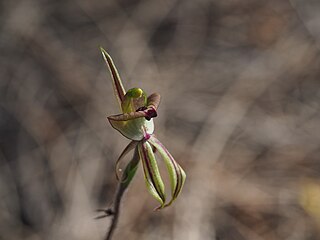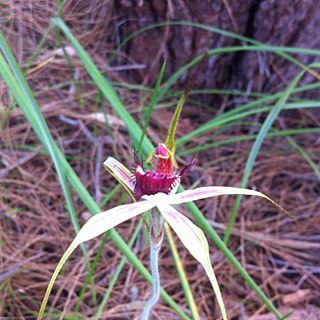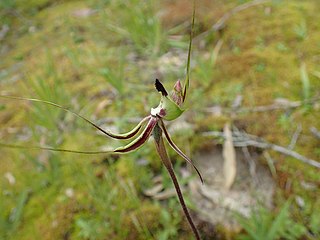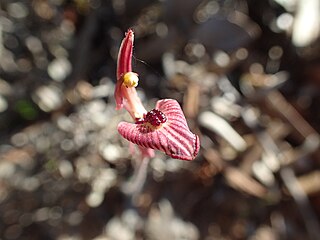
Caladenia brevisura, commonly known as the short-sepalled spider orchid, is a plant in the orchid family Orchidaceae and is endemic to the south-west of Western Australia. It is a common, small-flowered orchid with an erect, hairy leaf and a single greenish flower with red markings, on a flowering stem up to 25 cm (10 in) high. It is found between Ravensthorpe and Israelite Bay.

Caladenia corynephora, commonly known as the club-lipped spider orchid, is a plant in the orchid family Orchidaceae and is endemic to the south-west of Western Australia. It has a single erect, hairy leaf and one or two greenish-yellow and red flowers which have a labellum with a club-like tip. It is the only Western Australian caladenia with a clubbed labellum.
Caladenia cristata, commonly known as the crested clown orchid or crested spider orchid is a species of orchid endemic to a small area in the south-west of Western Australia. It has a single hairy leaf and a greenish-yellow and red flower on an unusually tall spike, considering the small size of the flower. Since its discovery in 1923 and collections made in 1923 it was thought to be extinct, until rediscovered in 1986.

Caladenia ensata, commonly known as the stumpy spider orchid, is a species of orchid endemic to the south-west of Western Australia. It is a common orchid within its natural range and has a single, hairy leaf and up to three pale yellow and red flowers which have short but thick, fleshy glandular tips.

Caladenia exstans, commonly known as the pointing spider orchid, is a species of orchid endemic to a small area in the south-west of Western Australia. It has a single, hairy leaf and one or two green, yellow and red flowers with a labellum which does not curl downwards but "points" forward.

Caladenia falcata, commonly known as the fringed mantis orchid, is a species of orchid endemic to the south-west of Western Australia. It is a relatively common orchid within its natural range and has a single, hairy leaf and one or two green, yellow and red flowers with spreading petals and upswept lateral sepals.

Caladenia flava subsp. flava, commonly known as the cowslip orchid, is a species of orchid endemic to the south-west of Western Australia. It is a relatively common orchid with a single, hairy leaf and up to three golden-yellow flowers which often have red markings.

Caladenia fluvialis, commonly known as the Brookton Highway spider orchid is a species of orchid endemic to the south-west of Western Australia. It is a recently discovered orchid with a single hairy leaf and one or two cream-yellow flowers with red markings on the labellum.
Caladenia graminifolia, commonly known as the grass-leafed spider orchid is a species of orchid endemic to the south-west of Western Australia. It has a single glabrous leaf and one or two short-lived, greenish-yellow and red flowers which have a narrow labellum with long teeth on its sides.
Caladenia graniticola, commonly known as the Pingaring spider orchid, is a species of orchid endemic to the south-west of Western Australia. It has a single, hairy leaf and one or two yellowish-green, red and white flowers which have a greenish-yellow and white labellum with a red tip. It was originally described as Caladenia hoffmanii subsp. graniticola but has a slightly different labellum and column.
Caladenia hoffmanii, commonly known as Hoffman's spider orchid is a species of orchid endemic to the south-west of Western Australia. It has a single, hairy leaf and one or two, greenish-yellow, red and white flowers which have a greenish-yellow labellum with a red tip. It is distinguished from the Pingaring spider orchid by small differences in the labellum and more northerly distribution.

Caladenia horistes, commonly known as the cream spider orchid is a species of orchid endemic to the south-west of Western Australia. It has a single, hairy leaf and one or two, creamy-yellow flowers which have a red-striped labellum and long, dark, thread-like tips on the sepals and petals.
Caladenia incrassata, commonly known as the puppet clown orchid is a species of orchid endemic to the south-west of Western Australia. It has a single, hairy leaf and usually only one greenish-yellow and red flower which has a red-striped labellum.

Caladenia attingens subsp. gracillima, commonly known as the small mantis orchid, is a species of orchid endemic to the south-west of Western Australia. It is a relatively common orchid with a single erect, hairy leaf and one or two green, yellow and red flowers. It differs from subspecies attingens in having smaller flowers and a more easterly distribution.
Caladenia attingens subsp. effusa, commonly known as granite mantis orchid, is a subspecies of orchid endemic to the south-west of Western Australia. It has a single erect, hairy leaf and one or two green, yellow and red flowers. It differs from the other subspecies of Caladenia attingens in having smaller flowers with lateral sepals which are not upswept and a labellum which is less than 15 mm (0.6 in) wide.

Caladenia microchila, commonly known as the western wispy spider orchid, is a species of orchid endemic to the south-west of Western Australia. It is relatively common orchid with a single erect, hairy leaf and up to three wispy white flowers with narrow lateral sepals and petals and a white labellum with red markings.

Caladenia pachychila, commonly known as the dwarf zebra orchid, is a species of orchid endemic to the south-west of Western Australia. It has a single erect, hairy leaf and one or two greenish-yellow and red flowers with a red-striped labellum which has a dense cluster of deep purple calli in its centre. It is similar to the zabra orchid but has smaller flowers and the lateral sepals do not clasp the ovary.
Caladenia remota subsp. remota, commonly known as the outback spider orchid, is a plant in the orchid family Orchidaceae and is endemic to the south-west of Western Australia. It has a single hairy leaf and one or two relatively large creamy-white to pale yellow flowers. It is relatively common in moist soil around granite outcrops, growing in more inland areas than most other spider orchids.
Caladenia voigtii, commonly known as the mohawk orchid, is a species of orchid endemic to the south-west of Western Australia. It has a single erect, hairy leaf and usually only one greenish-yellow and red flower. When discovered near Salmon Gums in 1977, it was thought to be the extinct Caladenia cristata, but when C. cristata was found near Miling, the Salmon Gums discovery was renamed C. voigtii.

Caladenia aperta, commonly known as the western tiny blue china orchid, is a plant in the orchid family Orchidaceae and is endemic to Western Australia. It has a relatively narrow leaf and a single bluish-mauve flower. It is distinguished from the other two similar blue orchids by the sides of the labellum which are erect but well-separated from the column. This species also has a more easterly distribution than C. amplexans and C. sericea.












